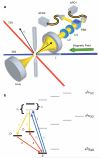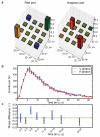Tunable ion-photon entanglement in an optical cavity
- PMID: 22622573
- PMCID: PMC4337972
- DOI: 10.1038/nature11120
Tunable ion-photon entanglement in an optical cavity
Abstract
Proposed quantum networks require both a quantum interface between light and matter and the coherent control of quantum states. A quantum interface can be realized by entangling the state of a single photon with the state of an atomic or solid-state quantum memory, as demonstrated in recent experiments with trapped ions, neutral atoms, atomic ensembles and nitrogen-vacancy spins. The entangling interaction couples an initial quantum memory state to two possible light-matter states, and the atomic level structure of the memory determines the available coupling paths. In previous work, the transition parameters of these paths determined the phase and amplitude of the final entangled state, unless the memory was initially prepared in a superposition state (a step that requires coherent control). Here we report fully tunable entanglement between a single (40)Ca(+) ion and the polarization state of a single photon within an optical resonator. Our method, based on a bichromatic, cavity-mediated Raman transition, allows us to select two coupling paths and adjust their relative phase and amplitude. The cavity setting enables intrinsically deterministic, high-fidelity generation of any two-qubit entangled state. This approach is applicable to a broad range of candidate systems and thus is a promising method for distributing information within quantum networks.
Figures




References
-
- Cirac JI, Zoller P, Kimble HJ, Mabuchi H. Quantum state transfer and entanglement distribution among distant nodes in a quantum network. Phys. Rev. Lett. 1997;78:3221–3224.
-
- Kimble HJ. The quantum internet. Nature. 2008;453:1023–1030. - PubMed
-
- Blinov BB, Moehring DL, Duan LM, Monroe C. Observation of entanglement between a single trapped atom and a single photon. Nature. 2004;428:153–157. - PubMed
-
- Olmschenk S, et al. Quantum teleportation between distant matter qubits. Science. 2009;323:486–489. - PubMed
-
- Volz J, et al. Observation of entanglement of a single photon with a trapped atom. Phys. Rev. Lett. 2006;96:030404. - PubMed
Publication types
Grants and funding
LinkOut - more resources
Full Text Sources
Other Literature Sources

